Abstract: Jazz Uncovered
9 September 2014
Celebrated saxophonist and MC SOWETO KINCH is one of the most versatile musicians in the UK today. Ever since he sneaked backstage at a Wynton Marsalis concert at the age of 13, his life has been shaped by jazz.
Here, in a special BBC Arts feature to accompany BBC Four Goes Abstract, the double MOBO winner highlights his favourite five jazz album covers inspired by abstract art.
Soweto Kinch
It is interesting that people like Jackson Pollock and other abstract artists said they listened to jazz. Romare Bearden would listen to Art Tatum extensively.
So there is something in the process of creation that makes this whole subject more interesting than just standard photographic representation of the artist.
There are pressures on the usual commercial artists to have either a picture of themselves on the product, or a pretty girl on the front.
The boldness in statement, the confidence to say 'I'm going to have an abstract image, I'm going to represent my music devoid of form, something that is memorable and something that is impactful' - that is what makes all of these albums quite special.

Abstraction
-
![]()
Exclusive features
When Art Broke Free: explore one of art's most groundbreaking forms with a season of special programmes, unique archive, and exclusive online content including films, features & timelines.

Mingus Ah Um by Charles Mingus
This is incredible - start to finish - as a piece of music. It is the same artist (Sadamitsu 'S. Neil' Fujita) that created Dave Brubeck’s work.
I think what is so interesting is you can draw your own lines of connections between the front cover and the content of the album which is, in part, fiercely political.
'Fables of Faubus' on the album is an instrumental song that had lyrics. There is some controversy as to if Mingus was asked by the label to take the lyrics off. It is all about an attack on Governor Faubus in Alabama who wouldn't allow black students into the Little Rock school campus.
The whole album is set in this political, racial context. The fact the lyrics aren't printed anywhere on the notes, or recorded for us to hear, suggests the abstract art allows the listener to draw their own political lines.
You can interpret the cover as two vaguely humanoid figurines, looking face to face. Or, if you look at it from another angle, you can almost see a deposed, perhaps black, face.
For me, it stands the test of time - even more than Brubeck's - because of its political relevance. It is an illustration of the feelings of the time. There is something grand about the scale of the album, and the artwork.
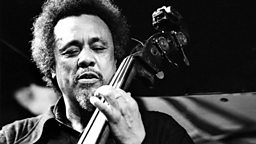

Charles Mingus Links

Saxophone Colossus by Sonny Rollins
I think the perspective, [the way] the photograph is shot and the way it is framed - it is larger than life.
Sonny Rollins' playing on the album is larger than life. The sounds he produces, the command of [improvisation], make him a saxophone giant.
I wanted to emulate that, even though it was 30 or 40 years before I was born.
The album itself, as well as that image which is so visually arresting, was something that really affected me.
The thing that really hit me was the monochrome black silhouette against the blue.
It fits into this tradition of the work of Aaron Douglas - the way that he paints African American figures in this larger than life, poster art, monochrome context is a visual language in itself.

Sonny Rollins Links
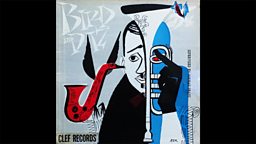
Bird and Diz by Charlie Parker and Dizzy Gillespie
There is surrealism in it and modernism in its style. Everything about it screams 'hip', in the bebop 1940s sense of the word.
It is all about reaching forward. It is progressive.
The music that African American jazz musicians were making in that post-war period - the visual language that accompanied that musical language was important.
In a sense, the album's artwork by David Stone Martin is not pure abstract art. It is geometric abstraction.
It reminds me of the music. Jazz in the period became a definite form and very real - chord changes, chorus, a melody that has to be referenced - but all the musicians test the boundaries of that.
It is almost like the artist is doing the same thing.
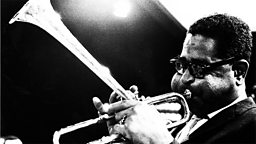
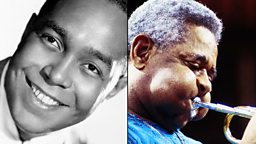
Bird and Diz Links
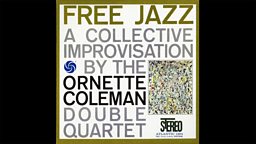
Free Jazz by Ornette Coleman
The album is free flowing. It is apparently without form, not bound by harmony. The music is pure improvisation.
A lot of very prominent improvisers of the time who understood that language and what Ornette Coleman was reaching for, like Freddie Hubbard, feature on the album.
In much the same way, the artwork seems to be the meeting of different voices, different perspectives, colliding in an apparent randomised way... but when you stand back from the image you see something holistic and something beautiful.
And when you look at the little box - of Jackson Pollock's painting White Light - that in itself is a snapshot of a moment in the music.
You take one little tiny section of the whole painting and extrapolate your own sense of meaning.
You then open up the cover, open up the music and extrapolate a whole world of other meaning.

Ornette Coleman Links
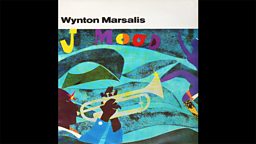
J Mood by Wynton Marsalis
Romare Bearden and Wynton Marsalis are both important in terms of what they have contributed to the jazz aesthetic.
The cover has a sense of style. The fact that some of the lines are so jagged yet there is a beautiful curve says something about the music as well.
It says something about form, and making the lines of the music more malleable. I think if you put this album in the context of Romare Bearden's other albums and his wider work, [that is] somebody who had a real sensitivity for the culture of jazz and the culture of music.
You cannot disassociate this cover, and Wynton's impact, from the artist Romare Bearden. There seems a conscious choice on Wynton's part to have a Bearden work.
Wynton is fully aware of the trajectory of how Bearden captured some of the earliest jazz musicians playing, how prolific he was and, perhaps, how Bearden is an unrecognised African American genius.
There is a personal connection of Wynton choosing the artist which I think is touching.
Wynton's music is very precise but at the same time incredibly virtuosic, and that is what I think these shapes are representing in the background of the album's artwork
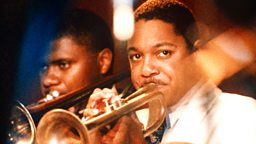
Wynton Marsalis Links
Abstraction
-
![]()
Exclusive features
When Art Broke Free: explore one of art's most groundbreaking forms with a season of special programmes, unique archive, and exclusive online content including films, features & timelines.
Art and Artists: Highlights
-
![]()
Ai Weiwei at the RA
The refugee artist with worldwide status comes to London's Royal Academy
-
![]()
BBC Four Goes Pop!
A week-long celebration of Pop Art across BBC Four, radio and online
-
![]()
Bernat Klein and Kwang Young Chun
Edinburgh’s Dovecot Gallery is hosting two major exhibitions as part of the 2015 Edinburgh Art Festival
-
![]()
Shooting stars: Lost photographs of Audrey Hepburn
An astounding photographic collection by 'Speedy George' Douglas
-
![]()
Meccano for grown-ups: Anthony Caro in Yorkshire
A sculptural mystery tour which takes in several of Britain’s finest galleries
-
![]()
The mysterious world of MC Escher
Just who was the man behind some of the most memorable artworks of the last century?
-
![]()
Crisis, conflict... and coffee
The extraordinary work of award-winning American photojournalist Steve McCurry
-
![]()
Barbara Hepworth: A landscape of her own
A major Tate retrospective of the British sculptor, and the dedicated museums in Yorkshire and Cornwall
Art and Artists
-
![]()
Homepage
The latest art and artist features, news stories, events and more from BBC Arts
-
![]()
A-Z of features
From Ackroyd and Blake to Warhol and Watt. Explore our Art and Artists features.
-
![]()
Video collection
From old Masters to modern art. Find clips of the important artists and their work












